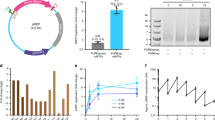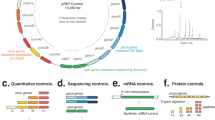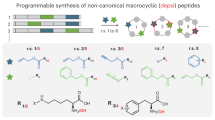Abstract
Since at least the last common ancestor of all life on Earth, genetic information has been stored in a four-letter alphabet that is propagated and retrieved by the formation of two base pairs. The central goal of synthetic biology is to create new life forms and functions1, and the most general route to this goal is the creation of semi-synthetic organisms whose DNA harbours two additional letters that form a third, unnatural base pair. Previous efforts to generate such semi-synthetic organisms2 culminated in the creation of a strain of Escherichia coli that, by virtue of a nucleoside triphosphate transporter from Phaeodactylum tricornutum, imports the requisite unnatural triphosphates from its medium and then uses them to replicate a plasmid containing the unnatural base pair dNaM–dTPT3. Although the semi-synthetic organism stores increased information when compared to natural organisms, retrieval of the information requires in vivo transcription of the unnatural base pair into mRNA and tRNA, aminoacylation of the tRNA with a non-canonical amino acid, and efficient participation of the unnatural base pair in decoding at the ribosome. Here we report the in vivo transcription of DNA containing dNaM and dTPT3 into mRNAs with two different unnatural codons and tRNAs with cognate unnatural anticodons, and their efficient decoding at the ribosome to direct the site-specific incorporation of natural or non-canonical amino acids into superfolder green fluorescent protein. The results demonstrate that interactions other than hydrogen bonding can contribute to every step of information storage and retrieval. The resulting semi-synthetic organism both encodes and retrieves increased information and should serve as a platform for the creation of new life forms and functions.
This is a preview of subscription content, access via your institution
Access options
Access Nature and 54 other Nature Portfolio journals
Get Nature+, our best-value online-access subscription
$29.99 / 30 days
cancel any time
Subscribe to this journal
Receive 51 print issues and online access
$199.00 per year
only $3.90 per issue
Buy this article
- Purchase on Springer Link
- Instant access to full article PDF
Prices may be subject to local taxes which are calculated during checkout



Similar content being viewed by others
References
Leduc, S. The Mechanisms of Life (Rebman, 1911)
Zhang, Y. et al. A semisynthetic organism engineered for the stable expansion of the genetic alphabet. Proc. Natl Acad. Sci. USA 114, 1317–1322 (2017)
Pédelacq, J. D., Cabantous, S., Tran, T., Terwilliger, T. C. & Waldo, G. S. Engineering and characterization of a superfolder green fluorescent protein. Nat. Biotechnol. 24, 79–88 (2006)
Mukai, T., Lajoie, M. J., Englert, M. & Söll, D. Rewriting the genetic code. Annu. Rev. Microbiol. 71, 557–577 (2017)
Liu, C. C. & Schultz, P. G. Adding new chemistries to the genetic code. Annu. Rev. Biochem. 79, 413–444 (2010)
Shimizu, M., Asahara, H., Tamura, K., Hasegawa, T. & Himeno, H. The role of anticodon bases and the discriminator nucleotide in the recognition of some E. coli tRNAs by their aminoacyl-tRNA synthetases. J. Mol. Evol. 35, 436–443 (1992)
Gorochowski, T. E., Avcilar-Kucukgoze, I., Bovenberg, R. A., Roubos, J. A. & Ignatova, Z. A minimal model of ribosome allocation dynamics captures trade-offs in expression between endogenous and synthetic genes. ACS Synth. Biol. 5, 710–720 (2016)
Chatterjee, A., Sun, S. B., Furman, J. L., Xiao, H. & Schultz, P. G. A versatile platform for single- and multiple-unnatural amino acid mutagenesis in Escherichia coli. Biochemistry 52, 1828–1837 (2013)
Nguyen, D. P. et al. Genetic encoding and labeling of aliphatic azides and alkynes in recombinant proteins via a pyrrolysyl-tRNA synthetase/tRNA(CUA) pair and click chemistry. J. Am. Chem. Soc. 131, 8720–8721 (2009)
Voss, S. & Skerra, A. Mutagenesis of a flexible loop in streptavidin leads to higher affinity for the Strep-tag II peptide and improved performance in recombinant protein purification. Protein Eng. 10, 975–982 (1997)
Hong, V., Presolski, S. I., Ma, C. & Finn, M. G. Analysis and optimization of copper-catalyzed azide–alkyne cycloaddition for bioconjugation. Angew. Chem. Int. Ed. 48, 9879–9883 (2009)
Wandrey, G. et al. Probing unnatural amino acid integration into enhanced green fluorescent protein by genetic code expansion with a high-throughput screening platform. J. Biol. Eng. 10, 11 (2016)
O’Donoghue, P., Ling, J., Wang, Y. S. & Söll, D. Upgrading protein synthesis for synthetic biology. Nat. Chem. Biol. 9, 594–598 (2013)
Chin, J. W. et al. Addition of p-azido-l-phenylalanine to the genetic code of Escherichia coli. J. Am. Chem. Soc. 124, 9026–9027 (2002)
Jewett, J. C., Sletten, E. M. & Bertozzi, C. R. Rapid Cu-free click chemistry with readily synthesized biarylazacyclooctynones. J. Am. Chem. Soc. 132, 3688–3690 (2010)
Young, T. S., Ahmad, I., Yin, J. A. & Schultz, P. G. An enhanced system for unnatural amino acid mutagenesis in E. coli. J. Mol. Biol. 395, 361–374 (2010)
Wang, K. et al. Optimized orthogonal translation of unnatural amino acids enables spontaneous protein double-labelling and FRET. Nat. Chem. 6, 393–403 (2014)
Smith, P. A. & Romesberg, F. E. Mechanism of action of the arylomycin antibiotics and effects of signal peptidase I inhibition. Antimicrob. Agents Chemother. 56, 5054–5060 (2012)
Engler, C., Kandzia, R. & Marillonnet, S. A one pot, one step, precision cloning method with high throughput capability. PLoS One 3, e3647 (2008)
Chan, W. T., Verma, C. S., Lane, D. P. & Gan, S. K. A comparison and optimization of methods and factors affecting the transformation of Escherichia coli. Biosci. Rep. 33, e00086 (2013)
Pirman, N. L. et al. A flexible codon in genomically recoded Escherichia coli permits programmable protein phosphorylation. Nat. Commun. 6, 8130 (2015)
Rappsilber, J., Mann, M. & Ishihama, Y. Protocol for micro-purification, enrichment, pre-fractionation and storage of peptides for proteomics using StageTips. Nat. Protocols 2, 1896–1906 (2007)
Link, A. J., Jennings, J. L. & Washburn, M. P. Analysis of protein composition using multidimensional chromatography and mass spectrometry. Curr. Prot. Protein Sci. 78, 23.21.21–23.21.25 (2001)
Beck, S. et al. The Impact II, a very high-resolution quadrupole time-of-flight instrument (QTOF) for deep shotgun proteomics. Mol. Cell. Proteomics 14, 2014–2029 (2015)
Moini, M., Jones, B. L., Rogers, R. M. & Jiang, L. Sodium trifluoroacetate as a tune/calibration compound for positive- and negative-ion electrospray ionization mass spectrometry in the mass range of 100–4000 Da. J. Am. Soc. Mass Spectrom. 9, 977–980 (1998)
Aerni, H. R., Shifman, M. A., Rogulina, S., O’Donoghue, P. & Rinehart, J. Revealing the amino acid composition of proteins within an expanded genetic code. Nucleic Acids Res. 43, e8 (2015)
Cox, J. & Mann, M. MaxQuant enables high peptide identification rates, individualized p.p.b.-range mass accuracies and proteome-wide protein quantification. Nat. Biotechnol. 26, 1367–1372 (2008)
MacLean, B. et al. Skyline: an open source document editor for creating and analyzing targeted proteomics experiments. Bioinformatics 26, 966–968 (2010)
Acknowledgements
We thank P. G. Schultz for the pEVOL-pAzF plasmid. This work was supported by the National Institutes of Health (GM118178 to F.E.R.). A.W.F. was supported by a National Science Foundation Graduate Research Fellowship (NSF/DGE-1346837).
Author information
Authors and Affiliations
Contributions
Y.Z., J.L.P. and F.E.R. designed experiments. Y.Z. and J.L.P. designed plasmids. Y.Z., E.C.F. and J.L.P. performed and interpreted translation experiments. H.R.A. conducted and interpreted MS experiments. C.E.C. developed methods. A.W.F. and K.S.J. provided technical assistance. C.R.T. and F.E.R. provided project leadership. F.E.R. provided overall project supervision. Y.Z. and F.E.R. wrote the manuscript, with input from the other authors.
Corresponding author
Ethics declarations
Competing interests
A provisional patent application has been filed by Synthorx and The Scripps Research Institute (application no. 62/531,325; inventors J.L.P., C.E.C., H.R.A., Y.Z., E.C.F., A.W.F., V.T. Dien and F.E.R.) covering the use of UBPs in tRNAs and mRNAs to produce proteins containing ncAAs. J.L.P., C.E.C., H.R.A., K.S.J., C.R.T. and F.E.R. have shares in Synthorx, Inc., a company that has commercial interests in the UBP.
Additional information
Reviewer Information Nature thanks A. Chatterjee, A. Deiters and P. Herdewyn for their contribution to the peer review of this work.
Publisher's note: Springer Nature remains neutral with regard to jurisdictional claims in published maps and institutional affiliations.
Extended data figures and tables
Extended Data Figure 1 Fluorescence of cells expressing sfGFP with various codons at position 151.
Strain YZ3 cells carrying a plasmid expressing TetR and an sfGFP plasmid with the indicated position 151 codon were grown to an OD600 of approximately 0.5 and induced with IPTG and aTc. Fluorescence measurements were taken after 3 h of induction. Data shown as mean with individual values, n = 3 cultures originating from the same colony and grown in parallel (technical replicates).
Extended Data Figure 2 Decoding of the AXC codon with natural near-cognate anticodons.
a, b, Fluorescence (a) and growth (b) of cells expressing sfGFP(AXC)151 with or without tRNASer with the indicated anticodon. Cells were induced as described in Fig. 1c, d and fluorescence measurements correspond to the last time point shown in Fig. 1c. Values for the GYT anticodon and in the absence of tRNASer (–tRNA) correspond to the same values in Fig. 1c, d. Individual data points (with means in a) shown from n = 4 cultures, each propagated from an individual colony (biological replicates).
Extended Data Figure 3 Western blots and growth of cells decoding AXC and GXC codons with tRNAPyl.
a, Western blot of lysates (normalized by OD600) from cells expressing sfGFP with the indicated position 151 codon, in the presence (+) or absence (–) of a tRNAPyl with a cognate anticodon, PylRS, or 20 mM PrK in the medium. Blots were probed with an anti-GFP antibody (N-terminal epitope). Cells were induced and collected at an equivalent time point, as described in Fig. 2b. For blot source data, see Supplementary Fig. 1. b, Growth of cultures analysed in Fig. 2a. The fold change in OD600 between induction of sfGFP (t = 1 h) and the final time point is greatest when all components necessary for aminoacylating tRNAPyl are present. Variations in the absolute value of OD600 are due to small variations in cell density at the start of T7 RNAP (and, if present, tRNAPyl) induction (t = 0). Individual data points shown from n = 4 cultures, each propagated from an individual colony (biological replicates).
Extended Data Figure 4 Decoding of AXC and GXC codons with tRNAPyl and cell growth as a function of added unnatural ribotriphosphates.
a, Fluorescence (upper panel) and western blots of purified sfGFP (lower panel) from cells expressing sfGFP and tRNAPyl with the position 151 codon/anticodon indicated, in the presence (+) or absence (–) of each unnatural ribotriphosphate in the medium, and with or without 20 mM PrK. Cells were induced as described in Fig. 2b and fluorescence measurements were taken at the end of induction (~3.5 h), before collecting the cells and purifying the sfGFP protein for click conjugation of TAMRA and western blotting. Western blots were probed with an anti-GFP antibody and imaged to detect both sfGFP and the conjugated TAMRA; all lanes correspond to sfGFP purified from cells grown with added PrK. Data shown as mean with individual values, n = 3 cultures, each propagated from an individual colony (biological replicates); ND, not determined. For blot source data, see Supplementary Fig. 1. b, Fluorescence and growth of cells expressing sfGFP(TAC)151 in the presence (+) or absence (–) of both unnatural deoxyribotriphosphates and each unnatural ribotriphosphate. t = 0 corresponds to the addition of IPTG to induce expression of T7 RNAP; aTc was added at t = 1 h to induce expression of sfGFP. Individual data points shown from n = 3 cultures, each propagated from an individual colony (biological replicates). At the concentrations used (see Methods), dNaMTP and dTPT3TP do not inhibit cell growth, whereas both unnatural ribotriphosphates, particularly TPT3TP, cause some inhibition of growth. c, Cell growth corresponding to the cultures with added PrK (20 mM) whose fluorescence is shown in Fig. 2b. Cells expressing sfGFP with natural codons were grown without any unnatural triphosphates, whereas cells expressing sfGFP with unnatural codons were grown with both unnatural deoxy- and ribotriphosphates. Individual data points shown from n = 4 cultures, each propagated from an individual colony (biological replicates).
Extended Data Figure 5 Decoding of AXC and GXC codons with tRNAPyl as a function of PrK concentration in the medium.
a, Western blots of sfGFP purified from cells expressing sfGFP and tRNAPyl with the indicated position 151 codon/anticodon, with conjugation of TAMRA and the addition of PrK to the medium at the indicated concentrations. sfGFP was induced and purified from cells collected as described in Fig. 2b. Western blots were probed with an anti-GFP antibody and imaged to detect both sfGFP and the conjugated TAMRA. For blot source data, see Supplementary Fig. 1. b, Fluorescence of cells (measured at the last time point shown in c) expressing sfGFP and tRNAPyl with the indicated position 151 codon and anticodon, respectively, as a function of PrK concentration in the medium. Fluorescence values for the 0 and 20 mM PrK conditions are the same as the (–) and (+) PrK conditions, respectively, shown in Fig. 2b. Individual data points shown from n = 4 cultures, each propagated from an individual colony (biological replicates). c, Timecourse analysis of fluorescence and cell growth in b. For clarity, only one representative culture (of four) is shown for each codon/anticodon pair and PrK concentration. We attribute the low level of sfGFP produced in the absence of PrK to decoding by endogenous tRNAs and loss of UBP retention in sfGFP (Extended Data Table 2). However, the relative amount of sfGFP that contains PrK (a) and absolute amount of sfGFP expressed (b, c) increased in a dose-dependent manner with increasing PrK in the medium, ultimately resulting in nearly full incorporation of PrK, suggesting that endogenous read-through of the AXC and GXC codons can be efficiently suppressed with sufficient concentrations of charged PrK-tRNAPyl(GYT) or PrK-tRNAPyl(GYC).
Extended Data Figure 6 Cell growth of the cultures whose fluorescence is shown in Fig. 3a.
Individual data points shown from n = 4 cultures, each propagated from an individual colony (biological replicates).
Supplementary information
Supplementary Information
This file contains Supplementary Figure 1, the uncropped source images of the blots and Supplementary Tables 1 and 2, a description of the plasmids and primers used in this study. (PDF 1448 kb)
Supplementary Notes
This file contains annotated sequences of plasmids denoted in Supplementary Table 1 suitable for direct import into sequence analysis software. (TXT 124 kb)
Rights and permissions
About this article
Cite this article
Zhang, Y., Ptacin, J., Fischer, E. et al. A semi-synthetic organism that stores and retrieves increased genetic information. Nature 551, 644–647 (2017). https://doi.org/10.1038/nature24659
Received:
Accepted:
Published:
Issue Date:
DOI: https://doi.org/10.1038/nature24659
This article is cited by
-
A CD25-biased interleukin-2 for autoimmune therapy engineered via a semi-synthetic organism
Communications Medicine (2024)
-
How scientists are hacking the genetic code to give proteins new powers
Nature (2023)
-
Quintuply orthogonal pyrrolysyl-tRNA synthetase/tRNAPyl pairs
Nature Chemistry (2023)
-
Enabling technology and core theory of synthetic biology
Science China Life Sciences (2023)
-
DNA origami: a tool to evaluate and harness transcription factors
Journal of Molecular Medicine (2023)
Comments
By submitting a comment you agree to abide by our Terms and Community Guidelines. If you find something abusive or that does not comply with our terms or guidelines please flag it as inappropriate.



